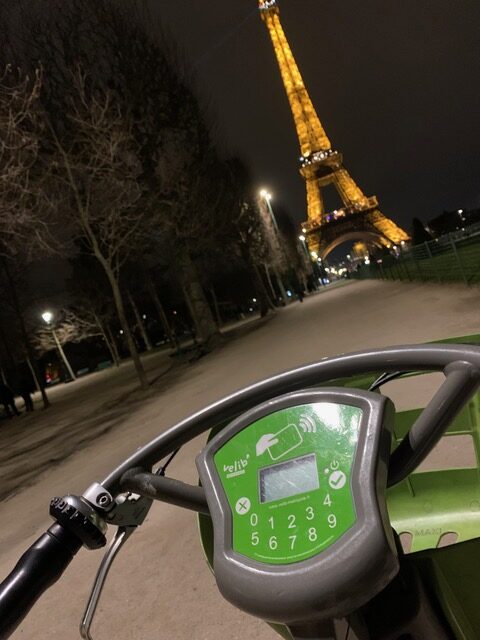 My favourite thing to do in Paris is to ride around on a Vélib, the almost free biking system. I wondered how much it had changed in seven years, as I’d heard a lot had changed. New operators. Competition from other bike schemes, more chaotically organised where people leave the bikes in random places. Electric scooters too, which I’m too afraid to try. And e-bikes. The current Vélib system has e-bikes.
My favourite thing to do in Paris is to ride around on a Vélib, the almost free biking system. I wondered how much it had changed in seven years, as I’d heard a lot had changed. New operators. Competition from other bike schemes, more chaotically organised where people leave the bikes in random places. Electric scooters too, which I’m too afraid to try. And e-bikes. The current Vélib system has e-bikes.
It was no simple thing to figure out how to use the system regularly while in Paris. Being there a week, I reckoned I’d need two 3-day passes, which requires getting a special identity card from the metro system. Going through the payment system and putting down a large deposit each time I used one would be too cumbersome.
But when I asked the fellow at the closest metro station about a card that I needed to use the Vélib system, he said, checking with his colleague, that he’d never heard of such a thing. While it was the only time this happened this week, this has happened a number of times on previous trips to Paris. It’s a guessing game. You ask for information directly but then end up asking questions to get negative responses until you finally ask the right one. In this case, even after rewording my question, I left, dejected, but then checked the information online, and found out I needed 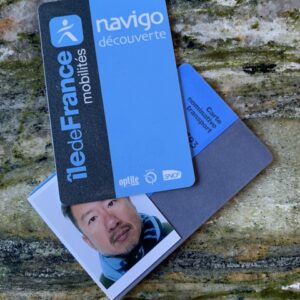 a ‘découverte’ card. It was only EUR 5 and required photos to stick to the card. Why hadn’t I brought those extra photos I kept for just such an occasion? There are actually photo booths all over Paris, and the train stations, so I made some photos for EUR 10, went and bought the proper card from the fellow (who sort of indicated, ‘oh, that’s what you wanted’) and then discovered that you really don’t need the photos on the card, and the photo doesn’t fit in any case. I cut it down to size and stuck in on anyways.
a ‘découverte’ card. It was only EUR 5 and required photos to stick to the card. Why hadn’t I brought those extra photos I kept for just such an occasion? There are actually photo booths all over Paris, and the train stations, so I made some photos for EUR 10, went and bought the proper card from the fellow (who sort of indicated, ‘oh, that’s what you wanted’) and then discovered that you really don’t need the photos on the card, and the photo doesn’t fit in any case. I cut it down to size and stuck in on anyways.
From there, you subscribe online for a pass, and are given an ID code and a password. The ID code shows up immediately on the Vélib app, so I assumed the password would too. But when I went out to get my first Vélib, it asked for the ID code, and THEN for the password, and the password was nowhere in sight. Where, where could it be? Nowhere it seemed. If you don’t write it down the first
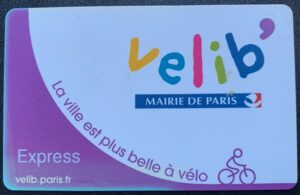
Seven years ago, I was so pleased to have obtained one of these, which allowed me to use the system the whole few months I was there, without renewing the pass every few days, like this trip.
time, you snooze, you lose. So, I called the helpline and the helpful person on English help reset my code and gave it to me. Hurrah. So, I rented my first Vélib bike and was surprised to see that after you enter in the ID code and the password, you then connect it to your travel card, and then don’t need to use them again! Just the card.
And then… after my first excursion, I put my bike back into one of the docking stations, and went for lunch. But then the next time I tried to use the bike, I couldn’t get one out. Sigh. I tried a few times, walked around and then took the Metro for the first (and only) time. When I got home, and called the helpline, I got the same person! Perhaps there is only one English helpdesk operator. She told me that I hadn’t docked the bike properly. Oops. She reset it for me, kindly, and soon after I received an email, in French, scolding me for being a bad Vélib user and asking me to be more careful from now on. How French, I thought.
 But sorry for all these details. The experience on the bikes was as good as ever. There are more bike paths than I remember, many of them wide, and busy with cyclists (and some scooters). What surprised me was that with so many Vélibs in use at all times, the biggest problem was not finding a Vélib but finding an empty spot to put the Vélibs back at the stations. Even though they seem to have a new system where you can put a Vélib back in a station when it’s full, by locking itself to something else, the one time I needed to try it, I couldn’t figure it out.
But sorry for all these details. The experience on the bikes was as good as ever. There are more bike paths than I remember, many of them wide, and busy with cyclists (and some scooters). What surprised me was that with so many Vélibs in use at all times, the biggest problem was not finding a Vélib but finding an empty spot to put the Vélibs back at the stations. Even though they seem to have a new system where you can put a Vélib back in a station when it’s full, by locking itself to something else, the one time I needed to try it, I couldn’t figure it out.
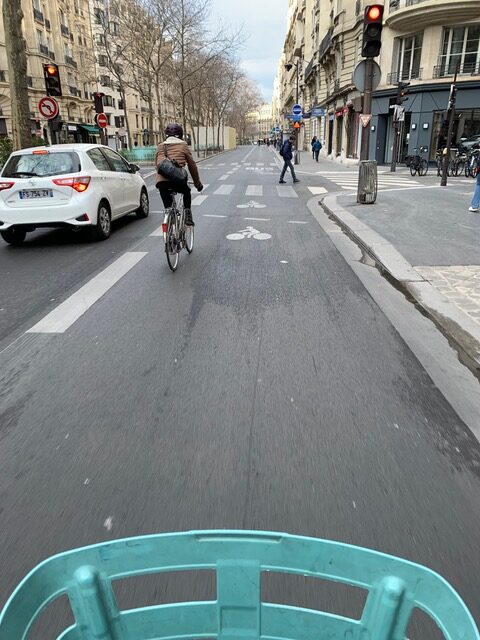 It was exhilarating and terrifying as you are often in busy traffic and super close to the cars. But the thing is, Parisian drivers seem to be use to all this chaos, and there are so many other bikes on the road. So, you just try your best, and cars move around you, and you around cars. The only time I saw people raise their voices was to prevent accidents, when a pedestrian or car or bike were really too close and about to collide.
It was exhilarating and terrifying as you are often in busy traffic and super close to the cars. But the thing is, Parisian drivers seem to be use to all this chaos, and there are so many other bikes on the road. So, you just try your best, and cars move around you, and you around cars. The only time I saw people raise their voices was to prevent accidents, when a pedestrian or car or bike were really too close and about to collide.
The bikes are in much better condition than they were seven years ago. The tires were filled. The seats were easily adjustable. There was occasionally the loud brake. Now, the ebikes are such a good idea, and there are as many ebikes as regular bikes, usually. But every time I tried to use them, I could feel an initial acceleration when I first got on, and then … nothing. Nada. I’m sad to report that it 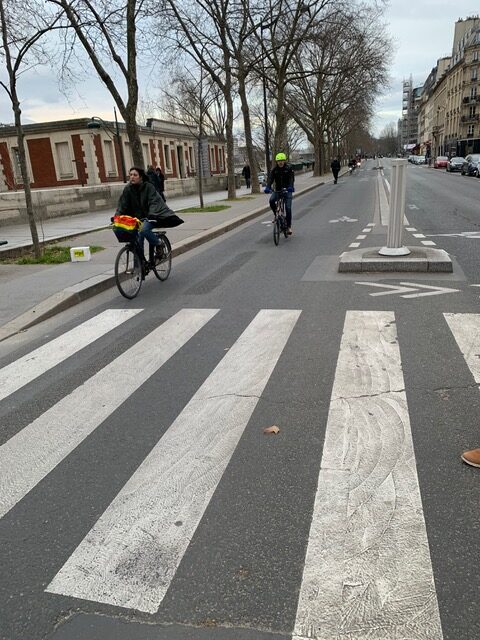 took me five days before a young colleague told me she’d had the same problem and you have to press ‘3’ on the dashboard to give it some juice, otherwise it stays in ‘1’. I only got to try a proper ebike once after that. Strangely, it was on a bike that someone had left at a station unlocked and still running (on their account), but they’d already set it on ‘3’ and what a difference it made. It was fast and quite fun.
took me five days before a young colleague told me she’d had the same problem and you have to press ‘3’ on the dashboard to give it some juice, otherwise it stays in ‘1’. I only got to try a proper ebike once after that. Strangely, it was on a bike that someone had left at a station unlocked and still running (on their account), but they’d already set it on ‘3’ and what a difference it made. It was fast and quite fun.
All in all, what a week. Paris is so compact that I used the metro only one time the whole time I was there, and the rest of the time, I was on a Vélib, or walked. I even went up to Sacre Coeur twice and was definitely winded, it would have been better with a functional ebike! What also made it easy was that I had internet access on my phone. Years ago this was so, so difficult to figure out, but nowadays, Virgin mobile in Australia just allows you to roam for $5 a day (about EUR 3) and being able to access my Vélib app and Google maps was a lifesaver. Of course, I got lost a ton of times and took wrong turns, but what better city in the world to be lost but Paris?
